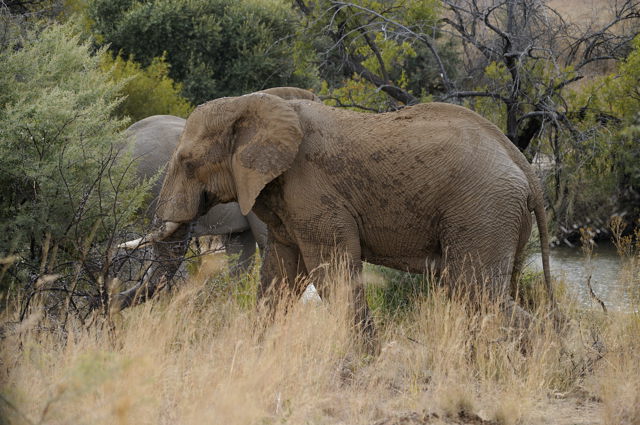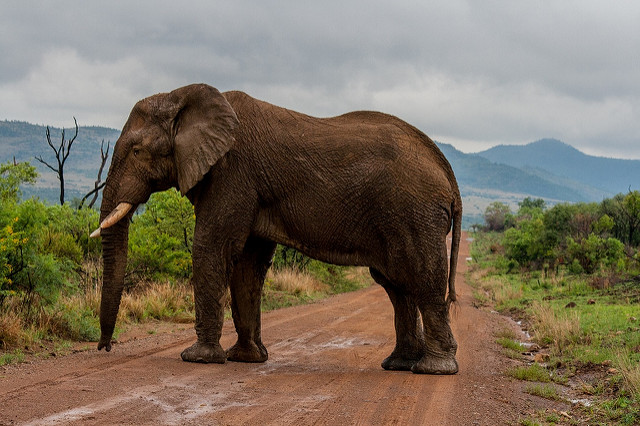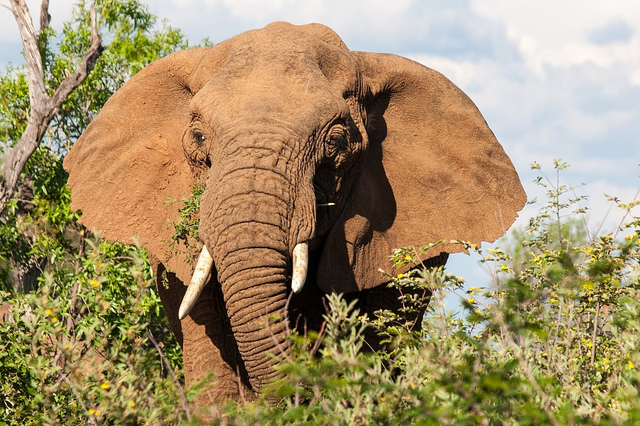Over the course of the early 1980s, 6000 animals were resettled into the Pilanesberg as part of Operation Genesis. It was the largest game resettlement programme in the history of the country. The 6000 animals were released into the quarantine area of 10 km² in groups and after a few weeks the fences were dropped.
In December 1981 the first group of elephants arrived from the Kruger, including an elephant affectionately named Less Than or LT due to a distinctive 'less than' sign on his face and 17 others.
At first the young elephants, unfamiliar with their new environment and without the direction of adult elephants, wandered around aimlessly until it was decided to call upon animal trainer and behaviourist Randall Moore in 1982 to assist. His first step was to bring in two adult cows both 18 years old and who had previously been trained as circus elephants and held in captivity in the United States for most of their lives named Owalla and Durga.
The cow’s had a simple task. They had to try and teach the youngsters about their surroundings, educate them on what they could eat, what they should avoid, and in general how to be an elephant. Randall stayed with the animals as long as he could ensuring they integrated with their surroundings and took the youngsters under their wing.
The calves soon sensed they needed the help and reluctantly handed their fates over to the two females in charge. But time marches on and as the young males started to grow up and reach maturity the young bull elephants were pushed out of the herd as is usual within elephant hierarchy – again left alone without much direction of what to do.
The behaviour of these young males soon astounded the game rangers of the Pilanesberg and as Gus van Dyk, the then field ecologist of the park mentioned at the time, that due to the structured nature of an elephant herd, any change in their history would have an impact on the animals later in their lives.
It wasn’t long after this that strange photographs started popping up. In one particular picture a young bull was caught on film trying to act like a rhinoceros. The elephants seemed to be drawn to the white rhino in particular, however were confused at the territorial behaviour of the rhino, as elephants themselves aren’t classically territorial animals.
But the rhino’s would be at an ill-fated receiving end of this behaviour and over 40 were known to have suffered fatal injuries from their encounters with these, now rogue, young bull elephants roaming through the park.
It wasn’t until in March 1993 when a confused and directionless young bull elephant attacked a tourist’s car and killed the occupant that it was decided that something needed to be done. In 1997 a team of experts were called upon to assist in working out a plan to change the behaviour of the animals and do something about what was a growing problem.
Joyce Poole, a wildlife researcher, was one of these experts and came all the way from Kenya to observe the elephants and to assist with offering up a working solution to the problem. Her initial findings were that the absence of dominant males could well be the problem, especially as they would be able to control the younger bulls while they were in Musth.
Must or Musth is a periodic condition in bull elephants, which is usually categorised by highly aggressive behaviour and accompanied by a large rise in reproductive hormones or testosterone.
Joyce also noted that in a normal elephant society only bulls of between 35 and 40 years of age would go into full Must and it was unheard of for young males of 23 to be in full “Must” for more than a few days. While many simply wanted the animals removed, both Gus and Joyce decided this wouldn’t be a viable solution as a roadmap needed to be worked out for all the parks that had received similar intakes of young bulls, and would serve as a solution to potential future problems.
It was as a result of this foresight that it was decided that six larger bulls from the Kruger National Park would be introduced into the Pilanesberg. Joyce warned the team that while the introduction of older males might reduce the Must period of the now “problem” youngsters and in turn put them in their place, it might not work.
In the interim Andre Klocke a young fulltime research assistant had been hired at the park to monitor the elephants. He was accompanied by a group of students from the Natal University who were tasked with gathering data on the behaviour of the young bulls, the way they interacted with the other animals and their behaviour patterns, all of which needed to be gathered before bringing in the older bulls.
This information would provide a before and after view of the behaviour of the animals, it also enabled the team to name and identify the different males. It was with this information and through this work that LT himself was recognised by his distinctive wrinkling on his forehead. At this stage LT had established himself as a dominant male and had adopted a herd of females of his own, albeit by elephant standards he was still too young to perform this role.
In 1998 the operation in the Kruger to collect males started and an initial two large males were selected for their new role at the Pilanesberg. The goal would be to dart and collar them so that their movements at their new home could be tracked. One of the elephants was named Thabo, which means happiness, he measured 3.5m tall, which was the maximum size of elephant that could fit into the transport truck and he weighed in at six tons.
After their long trip from the Kruger to the Pilanesberg the elephant males were put into a large electrified boma to adjust before being moved into the park. After the two young elephants were released from the boma, the team, headed by Andre, began looking for the Kruger males making use of the telemetry systems hooked into their collars.
After more than 24 hours Thabo was the first to be spotted, in tow was a young Pilanesberg male who showed immediate signs of submission to the gargantuan Thabo.
However at the same time one of the older female cows Owalla suffered an injury after a skirmish with a hippo, an injury that was worsening and looking to prove to be fatal unless treated, so a veterinary team was called in to assist. While ordinarily such an injury would be left and nature would be required to take its course, the female’s role with the six males coming from the Kruger was as important as the males themselves as she would help set the tone for what would come.
But the initial treatment didn’t work for Owalla and the team had to repeat them a number of times with no success. Eventually at their wits end the team called upon Randall Moore once more to see if she would recognise him, after a 17 year absence, and allow them to work on her without having to sedate her. Amazingly she did and after a while she, with Randall at her side allowed the vets to work on her wounds without being sedated – showing the remarkable memory of these magnificent creatures.
All the while this was happening in the Pilanesberg, Gus and his team were back at the Kruger selecting more elephants to rehome, opting to find animals from the same area where Thabo was captured in the hope they would recognise each other, the next two were called Philani and Mavuso, while the final two were Amarula and Lebombo.
After some time in the park, four of the Kruger bulls decided to stick together, forming their own smaller herd of familiar males, all but one who had taken a herd of his own. In the other breeding herds nothing really changed and the young bulls still ruled the roost for the time being, as the remaining Kruger bulls hadn’t as yet managed to chase them away.
The one Kruger male who at this time had his female herd was soon confronted by a boisterous Pilanesberg male now in Must, showing his interest to the females he was summarily dismissed by the Kruger bull and put in his place – the first major breakthrough for the team.
However on the side lines the other Kruger males, while not yet looking to enter a female breeding herd, were dominating the younger Pilanesberg males and asserting dominance over their rambunctious behaviour. Perhaps more notably the rhino were being left alone and no more fatalities or wounds were reported from confused young male elephants trying to “fit” in with a different species.
Almost a year later the bulk of the Kruger bulls were still happily going along their business without having challenged the youngsters. But it was around this time that a young Pilanesberg male named Cyclops came into Must at the same time as Mavuso one of the larger Kruger males and both attempted to join the same female herd. After a massive showdown Cyclops had to admit defeat and make way for the older, larger, and more seasoned Kruger male – finally putting the final peg in the plan of Gus and his team as he took over the heard.
All in all the project was a huge success but a number of lessons were learnt along the way. According to Gus one of these lessons is that the role of the male elephant is a critical one, particularly in what has been traditionally viewed as the matriarchal society of an elephant herd.
To this end he says that the males have a critical role to play in the formation of the hierarchy and Mavuso and the other Kruger males showed that it is only through a no- nonsense approach that they could restore the equilibrium of the herd.
Today the Pilanesberg Elephant herds thrive and more importantly the youngsters know their place in an environment where at a stage there seemed to be little regard for the laws of nature.
Source: http://www.legacyinspires.com/news.cfm?articleid=225
Elephants of Pilanesberg - Chats and Discussions
- Flutterby
- Posts: 44029
- Joined: Sat May 19, 2012 12:28 pm
- Country: South Africa
- Location: Gauteng, South Africa
- Contact:
Re: Elephants of Pilanesberg
We would now like to build up a database of elephants in the Pilanesberg National Park. Any pics or info will be greatly appreciated. If the elephant is a named elephant, please add the name, otherwise we will attempt to get an identification. Please post the date and place where your picture was taken.
Re: Elephants of Pilanesberg
Hi Flutt's, 
Nice thread.
I only have two pics of Pilanesberg bulls, and they are 4 years old now. (the pics, not the bulls).
I named them Bob & Eddie (because I can and no-one can stop me )
) 
Anyways, if they are one of the ellies above, I don't mind calling them by their proper names, but will reserve the right to call them Bob & Eddie as my own personal nick-names. As this has now been classed as a proper science elsewhere, does that mean that I'm a qualified scientist now that I've named a couple of ellies? (Aat must have several phd's on that basis. ).
).
Bob

Eddie

Please have a giggle, use/move the pics for ID purposes then delete/move the post as required.
Nice thread.
I only have two pics of Pilanesberg bulls, and they are 4 years old now. (the pics, not the bulls).
I named them Bob & Eddie (because I can and no-one can stop me
Anyways, if they are one of the ellies above, I don't mind calling them by their proper names, but will reserve the right to call them Bob & Eddie as my own personal nick-names. As this has now been classed as a proper science elsewhere, does that mean that I'm a qualified scientist now that I've named a couple of ellies? (Aat must have several phd's on that basis.
Bob

Eddie

Please have a giggle, use/move the pics for ID purposes then delete/move the post as required.
Dewi
What is the good of having a nice house without a decent planet to put it on? (H D Thoreau)
What is the good of having a nice house without a decent planet to put it on? (H D Thoreau)
- nan
- Posts: 26472
- Joined: Thu May 31, 2012 9:41 pm
- Country: Switzerland
- Location: Central Europe
- Contact:
Re: Elephants of Pilanesberg
welcome Bob & Eddie 



Kgalagadi lover… for ever
https://safrounet.piwigo.com/
https://safrounet.piwigo.com/
-
steamtrainfan
- Posts: 3252
- Joined: Wed Jun 06, 2012 9:17 pm
- Contact:
Re: Elephants of Pilanesberg
Thanks very much for starting this thread Flutterby - I am sure it is going to prove to be most interesting.
Here are some unidentified ellies we saw in December 2013. Can anyone give them names.



Any chance of these three photos being of the same ellie - smaller right hand tusk???????????
Will put some more up later.
Here are some unidentified ellies we saw in December 2013. Can anyone give them names.



Any chance of these three photos being of the same ellie - smaller right hand tusk???????????
Will put some more up later.
Last edited by steamtrainfan on Fri Mar 21, 2014 9:08 pm, edited 1 time in total.
Faith is the bird that feels the light while the dawn is still dark. Author unknown.
-
steamtrainfan
- Posts: 3252
- Joined: Wed Jun 06, 2012 9:17 pm
- Contact:
Re: Elephants of Pilanesberg
Amarula rubbing up against a game viewing truck. I am so pleased I was not in the cab on the passenger side. 

Faith is the bird that feels the light while the dawn is still dark. Author unknown.
Re: Elephants of Pilanesberg
Dewi
What is the good of having a nice house without a decent planet to put it on? (H D Thoreau)
What is the good of having a nice house without a decent planet to put it on? (H D Thoreau)
-
steamtrainfan
- Posts: 3252
- Joined: Wed Jun 06, 2012 9:17 pm
- Contact:
Re: Elephants of Pilanesberg
Thanks very much Dewi. 
Faith is the bird that feels the light while the dawn is still dark. Author unknown.
- nan
- Posts: 26472
- Joined: Thu May 31, 2012 9:41 pm
- Country: Switzerland
- Location: Central Europe
- Contact:
Re: Elephants of Pilanesberg
everybody waited the last minute to move
Kgalagadi lover… for ever
https://safrounet.piwigo.com/
https://safrounet.piwigo.com/
-
steamtrainfan
- Posts: 3252
- Joined: Wed Jun 06, 2012 9:17 pm
- Contact:
Re: Elephants of Pilanesberg
Indeed nan - he certainly showed them who is boss of the road.
Faith is the bird that feels the light while the dawn is still dark. Author unknown.


